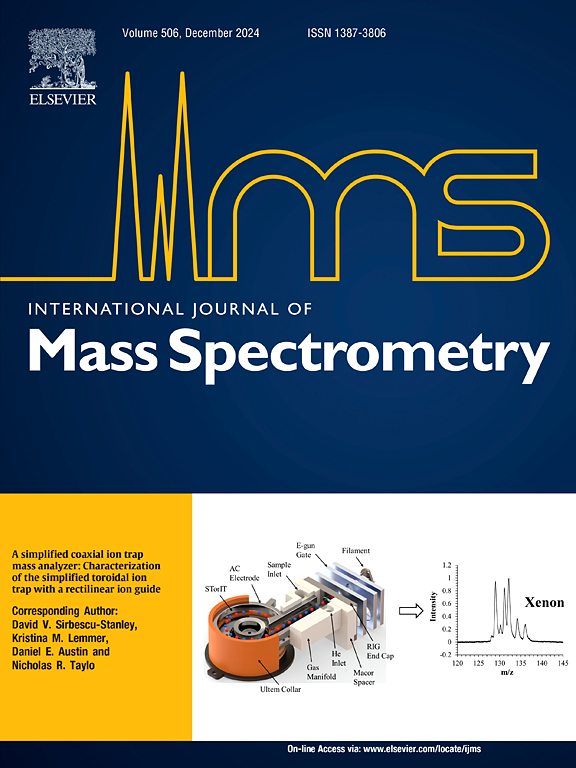Spatial mapping of phosphatidylcholine sn-positional isomers using CID of divalent metal complexes in imaging mass spectrometry
IF 1.7
3区 化学
Q3 PHYSICS, ATOMIC, MOLECULAR & CHEMICAL
引用次数: 0
Abstract
Phosphatidylcholines (PCs) are the main components of cellular membranes. The high degree of structural heterogeneity leads to significant variations in PC functions and complicates structural characterization. For example, the complex mixtures of lipid structures create challenges when analyzing and identifying these compounds directly from tissue in matrix-assisted laser desorption/ionization (MALDI) imaging mass spectrometry experiments. Phosphatidylcholine (PCs) are preferentially ionized in the positive ion mode in MALDI imaging mass spectrometry. However, low-energy collision induced dissociation (CID) of protonated PCs largely only results in cleavages of the phosphocholine headgroup, with little to no information obtained about the fatty acyl chain identities and positions. Alternatively, metal cationization of lipids is known to generate increased structural information upon CID, but metal coordination has been less studied. Herein, we highlight the use of divalent metal-ligand complexes to produce new ion types for CID analysis in MALDI imaging mass spectrometry. CID of the new [PC + M + ligand]+ ion type (where M is a divalent metal) eliminates the headgroup loss fragmentation channel and opens new fragmentation channels at the fatty acyl chain positions. The gas-phase fragmentation behavior of [PC + M + ligand]+ ion type is characterized using multiple divalent metals and ligands. The fatty acyl chain product ions are then used to relatively quantify sn-positional isomers. Furthermore, this method is integrated into an imaging mass spectrometry workflow to enable the spatial mapping of PC sn-positional isomers in rat brain and glioblastoma tissues, revealing differential distributions of the sn-positional isomers.

成像质谱法中二价金属配合物CID对磷脂酰胆碱非位置异构体的空间定位
磷脂酰胆碱(PCs)是细胞膜的主要成分。高度的结构异质性导致PC功能的显著差异和复杂的结构表征。例如,在基质辅助激光解吸/电离(MALDI)成像质谱实验中,当直接从组织中分析和鉴定这些化合物时,脂质结构的复杂混合物带来了挑战。磷脂酰胆碱(PCs)在MALDI成像质谱法中以正离子模式优先电离。然而,质子化pc的低能碰撞诱导解离(CID)在很大程度上只导致磷酸胆碱头基团的断裂,很少甚至没有关于脂肪酰基链的身份和位置的信息。另外,已知脂质的金属阳离子化会在CID时产生增加的结构信息,但对金属配位的研究较少。在这里,我们强调使用二价金属配体配合物来产生新的离子类型,用于MALDI成像质谱中的CID分析。新的[PC + M +配体]+离子型(其中M为二价金属)的CID消除了头基损失的断裂通道,并在脂肪酸酰基链位置打开了新的断裂通道。用多种二价金属和配体表征了[PC + M +配体]+离子型的气相断裂行为。然后用脂肪酸酰基链产物离子相对定量非位置异构体。此外,该方法集成到成像质谱工作流程中,实现了大鼠脑和胶质母细胞瘤组织中PC单位异构体的空间映射,揭示了单位异构体的差异分布。
本文章由计算机程序翻译,如有差异,请以英文原文为准。
求助全文
约1分钟内获得全文
求助全文
来源期刊
CiteScore
3.60
自引率
5.60%
发文量
145
审稿时长
71 days
期刊介绍:
The journal invites papers that advance the field of mass spectrometry by exploring fundamental aspects of ion processes using both the experimental and theoretical approaches, developing new instrumentation and experimental strategies for chemical analysis using mass spectrometry, developing new computational strategies for data interpretation and integration, reporting new applications of mass spectrometry and hyphenated techniques in biology, chemistry, geology, and physics.
Papers, in which standard mass spectrometry techniques are used for analysis will not be considered.
IJMS publishes full-length articles, short communications, reviews, and feature articles including young scientist features.

 求助内容:
求助内容: 应助结果提醒方式:
应助结果提醒方式:


